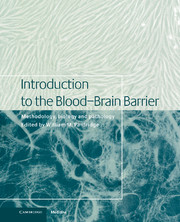Book contents
- Frontmatter
- Contents
- List of contributors
- 1 Blood–brain barrier methodology and biology
- Part I Methodology
- Part II Transport biology
- Part III General aspects of CNS transport
- Part IV Signal transduction/biochemical aspects
- 31 Regulation of brain endothelial cell tight junction permeability
- 32 Chemotherapy and chemosensitization
- 33 Lipid composition of brain microvessels
- 34 Brain microvessel antigens
- 35 Molecular dissection of tight junctions: occludin and ZO-1
- 36 Phosphatidylinositol pathways
- 37 Nitric oxide and endothelin at the blood–brain barrier
- 38 Role of intracellular calcium in regulation of brain endothelial permeability
- 39 Cytokines and the blood-brain barrier
- 40 Blood–brain barrier and monoamines, revisited
- Part V Pathophysiology in disease states
- Index
33 - Lipid composition of brain microvessels
from Part IV - Signal transduction/biochemical aspects
Published online by Cambridge University Press: 10 December 2009
- Frontmatter
- Contents
- List of contributors
- 1 Blood–brain barrier methodology and biology
- Part I Methodology
- Part II Transport biology
- Part III General aspects of CNS transport
- Part IV Signal transduction/biochemical aspects
- 31 Regulation of brain endothelial cell tight junction permeability
- 32 Chemotherapy and chemosensitization
- 33 Lipid composition of brain microvessels
- 34 Brain microvessel antigens
- 35 Molecular dissection of tight junctions: occludin and ZO-1
- 36 Phosphatidylinositol pathways
- 37 Nitric oxide and endothelin at the blood–brain barrier
- 38 Role of intracellular calcium in regulation of brain endothelial permeability
- 39 Cytokines and the blood-brain barrier
- 40 Blood–brain barrier and monoamines, revisited
- Part V Pathophysiology in disease states
- Index
Summary
Introduction
Membrane lipids containing fatty acids are important as they play a direct role in the structure and function of cells, including brain endothelial cells. Moreover, these latter cells transfer fatty acids from the blood to the brain cells. Brain is the second organ in terms of lipid content, after adipose tissue; in brain, lipids do not provide any energy, but play a structural role: they participate in the structure of membranes, and thus mediate their functions. This transfer is obligatory for essential fatty acids of dietary origin, but it is not yet known whether the essential linoleic (18:2(n-6)) and alphalinolenic (18:3(n-3)) acids are transferred, or whether it is the longer chains that are in fact transferred (mainly arachidonic acid, 20:4(n-6); and docosahexaenoic acid, 22:6(n-3), DHA).
Thus brain microvessel metabolism controls brain membrane polyunsaturated fatty acids. This is of special importance as, for instance, alterations in dietary (n-3) polyunsaturated fatty acids change the fatty acid profile of brain cell membranes (neurons, astrocytes and oligodendrocytes) and subcellular fractions (myelin and nerves endings) (Bourre et al., 1984), and thus alter brain structure and functions including learning performance. This has been documented in animal models (Bourre et al., 1989), and in human infants.
- Type
- Chapter
- Information
- Introduction to the Blood-Brain BarrierMethodology, Biology and Pathology, pp. 308 - 313Publisher: Cambridge University PressPrint publication year: 1998

